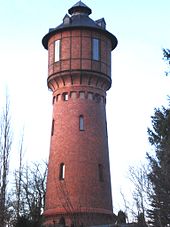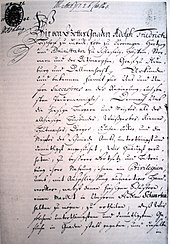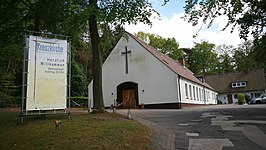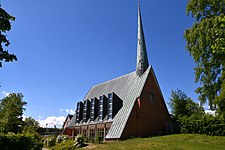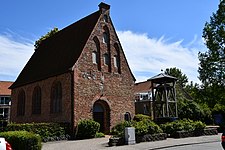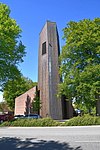Bad Schwartau
| coat of arms | Germany map | |
|---|---|---|

|
Coordinates: 53 ° 55 ' N , 10 ° 42' E |
|
| Basic data | ||
| State : | Schleswig-Holstein | |
| Circle : | Ostholstein | |
| Height : | 8 m above sea level NHN | |
| Area : | 18.39 km 2 | |
| Residents: | 20,044 (Dec. 31, 2019) | |
| Population density : | 1090 inhabitants per km 2 | |
| Postal code : | 23611 | |
| Area code : | 0451 | |
| License plate : | OH | |
| Community key : | 01 0 55 004 | |
| LOCODE : | DE BSU | |
City administration address : |
Markt 15 23611 Bad Schwartau |
|
| Website : | ||
| Mayor : | Uwe Brinkmann (independent) | |
| Location of the city of Bad Schwartau in the Ostholstein district | ||

Bad Schwartau ( Low German : Bad Swartau ) is the largest city in the Ostholstein district in Schleswig-Holstein (Germany) and a state-recognized iodine brine and mud spa . The city lies on the Schwartau River immediately to the north, bordering Lübeck and forms an agglomeration with this city .
Neighboring communities
Districts
According to the main statutes of the city of Bad Schwartau, Bad Schwartau is divided into five districts:
history
The place name goes back to the Wendish name of the river Schwartau, which is interpreted as "the meandering". This refers to the very winding lower course of the river before it was straightened much later.
Before 1600
In 1177 the current district of Rensefeld was first mentioned in a document, the episcopal mill Schwartau Molendinium szwartowe was first mentioned in a document in 1215. In 1258, the Lübeck bishop set up an infirmary ("Domus leprosum"), the Schwartau infirmary , for lepers near today's St. George's Chapel . In the 15th century - after the leprosy (“leprosy”) had subsided - it was converted into an old people's and later poor house. In 1280, the Lübeck bishop Burkhard von Serkem founded the Kaltenhof farm outside the city of Lübeck an der Schwartau.
17th century
Around 1640, the Kaltenhof episcopal office was relocated to Schwartau, which developed into a market town.
18th century
From December 20 to 31, 1712 (during the Great Northern War ), the Swedish commander Magnus Stenbock set up his headquarters in Schwartau. In 1742, the issued prince bishop of the diocese of Lübeck Adolf Friedrich Schwartau the first market rights for the Monday and Tuesday before St. John (June 24), this market is a privilege to two days before 1763 Michaeli extended (September 29).
19th century

After the Battle of Lübeck , the Prussian troops under Blücher passed through Schwartau on November 6, 1806 on their way to Ratekau . The French troops following them looted . In 1842 the offices of Kaltenhof and Großvogtei were combined to form the office of Schwartau in the Principality of Lübeck / Grand Duchy of Oldenburg .
On November 1, 1859, Schwartau was given the status of a community by the new Oldenburg municipal code .
In the run-up to the German-Danish War , the Schwartau turnpike was destroyed by Prussian troops in 1864, thereby violating the neutrality of the Grand Duchy of Oldenburg (" storming the Schwartau turnpike ").
In 1899 the Schwartau works are opened by the brothers Paul and Otto Fromm.
In the beginning of the 20th century
Before 1900, Schwartau developed into a climatic health resort (" summer resort ") where guests can relax from the air pollution in large cities that came with industrialization. At the same time, Schwartau became a popular place of residence / retirement, which led to the development of villa colonies in Schwartau , Cleverbrück and Kaltenhof . In 1895 the first brine spring with a high iodine content was discovered. In 1901 Anton Baumann opened the "Elisabeth-Sol- und Moorbad", with which the development of the spa and bathing system in Bad Schwartau began .
In 1912 Schwartau was granted town charter , one year later Schwartau became Bad .
National Socialism and World War II
On October 26, 1932, Hitler held his campaign appearance originally planned for November 6 ( Lübeck ) on the Riesebusch sports field . In order to reach as large a number as possible, the NSDAP events took place in the open air. The Lübeck Market Place was the NSDAP due fountain, tree line and Kaak, too small, the alternate location, the Buniamshof , was the party too far away. Ergo the event was moved to Bad Schwartau . - In Bad Schwartau, too, people were persecuted during the National Socialist era. Today a number of stumbling blocks in Bad Schwartau testify to these persecutions.
In 1934 the villages of Rensefeld , Groß Parin and Cleverbrück were incorporated into the dissolved rural community of Rensefeld . In 1937, due to the Greater Hamburg Act , Schwartau was transferred from the Free State of Oldenburg to the Prussian province of Schleswig-Holstein as part of the Eutin district formed from the Principality of Lübeck .
Bad Schwartau was largely spared from air raids during the Second World War . During the Battle of Berlin , immediately after Hitler's last birthday, on April 20, 1945, prepared evacuation measures were carried out by the Reich government, Reich ministries and the security apparatus. All Reich Ministers then gathered in the Eutin - Plön area , north of Bad Schwartau, as this area was still free of combat. The newly appointed President of the People's Court Harry Haffner also fled to Schleswig-Holstein. After the previous chairman, Roland Freisler , died in an air raid in February 1945, Hitler appointed him the new President of the People's Court on March 12, 1945. Haffner sat on 24 April 1945 the advice of Wilhelm Keitel of Potsdam after Schwerin , and from there to Bad Schwartau. In Bad Schwartau he wanted to re-establish the People's Court. Before the approaching British troops, Karl Dönitz , who had been appointed Reich President before Hitler's suicide , fled together with the last Reich government on May 2, 1945 from Plön to Flensburg - Mürwik . The People's Court was evidently not moved to Flensburg, but this did not mean that the Nazi military justice system there did not pass harsh judgments. There is no further evidence of the activities of the People's Court in Bad Schwartau. The occupation of Bad Schwartau by the English troops prevented further activities of the People's Court. On May 4, 1945, Hans-Georg von Friedeburg signed the surrender of all German troops in northwest Germany, the Netherlands and Denmark on behalf of Dönitz . The war finally ended with the Unconditional Surrender on May 8th . On October 20, 1945, the Allied Control Council also finally dissolved the People's Court.
post war period
During the Cold War , the relics of the Second World War, the blasting shafts along the Kaltenhöfer Strasse, were integrated into the street so that the bridge over the Schwartau could be blown up in an emergency. It was assumed that enemy forces were advancing from the east and some bridges over the Schwartau were equipped with blasting pits along the natural obstacle Schwartau, its valley cuts and surrounding wetlands. The associated five pioneer barrier houses (explosives bunkers) are located near the Ratekauer Blocksberg and are used as bat housing. A blast shaft cover is now in the Schwartau Museum.
In 1957, the city of Bad Schwartau acquired the spa from Schwartauer Werke and in 1994 sold the city's spa to private sponsorship.
Population development
- December 31, 1912: approx. 4,000
- December 31, 1934: approx. 7,000 (after the incorporation)
With the arrival after the end of the Second World War , the number of inhabitants doubled. Since 1998 there has been a slight decrease in the number of inhabitants. However, the population has been growing again since 2010.
|
|
politics
City Council
The last three local elections on May 6, 2018 , May 26, 2013 and May 25, 2008 produced the following results:
| Parties and constituencies | % 2018 |
Seats 2018 |
% 2013 |
Seats 2013 |
% 2008 |
Seats 2008 |
|||
|---|---|---|---|---|---|---|---|---|---|
| CDU | Christian Democratic Union of Germany | 40.5 | 11 | 42.2 | 14th | 49.1 | 15th | ||
| SPD | Social Democratic Party of Germany | 29.5 | 8th | 29.1 | 9 | 26.6 | 8th | ||
| WBS | Bad Schwartau voter community | - | - | 14.0 | 4th | 17.9 | 5 | ||
| GREEN | Alliance 90 / The Greens | 20.8 | 5 | 11.3 | 4th | - | - | ||
| FDP | Free Democratic Party | 7.2 | 2 | 3.3 | 1 | 6.4 | 1 | ||
| BfBS | Citizens for Bad Schwartau | 2.0 | 1 | - | - | - | - | ||
| total | 100 | 27 | 100 | 32 | 100 | 29 | |||
| voter turnout | 43.3% | 46.8% | 43.6% | ||||||
mayor
Since a change in local electoral law in 1998, the head of the city administration is no longer elected by the city council, but by direct election. The main statute of the city of Bad Schwartau currently provides for an election period of six years. In the last election in 2016, in addition to the applicants from the SPD and CDU, three independent candidates stood for election, whereby the non-party applicant from the SPD prevailed in the runoff election on May 8 with 67.7% of the votes against the parliamentary group chairman of the CDU.
- since 2016: Uwe Brinkmann (independent)
- 2001-2016: Gerd Schubert (CDU)
- 1990–2001: Joachim Wegner (CDU)
- 1976–1990: Rainer Bahrdt (SPD)
.....
- 1920-xxxx: Richard Franke
- xxxx-1920: Wilhelm Gleiniger
coat of arms
Blazon : “Split and half split. On the right a black diagonal right-hand wave bar in silver, on the top left in blue a gold cross with simple notches at the thickened ends, on the bottom left in gold two red bars. "
The coat of arms was approved in 1948. The wavy bar represents the Schwartau river . The cross comes from the coat of arms of the former Diocese of Lübeck and the bar comes from the coat of arms of the former Grand Duchy of Oldenburg .
flag
Bad Schwartau has had a flag since 1961. This shows the black wavy line of the Schwartau from top left to bottom right and in the lower left quarter the red cross on a white background.
Partnerships and sponsorships
There are city partnerships with the following cities:
-
 Villemoisson-sur-Orge in the canton of Longjumeau , Île-de-France , France , since 1999
Villemoisson-sur-Orge in the canton of Longjumeau , Île-de-France , France , since 1999 -
 Czaplinek , formerly Tempelburg ( Pomerania ), Poland , since 1993
Czaplinek , formerly Tempelburg ( Pomerania ), Poland , since 1993 -
 Bad Doberan , ( Mecklenburg-Western Pomerania ), since 1991
Bad Doberan , ( Mecklenburg-Western Pomerania ), since 1991
The city has taken over the sponsorship for the 5th company of the reconnaissance battalion 6 of the Bundeswehr in Eutin .
Culture and sights

Bad Schwartau is nicknamed "The iodine brine - and mud spa of the north". With an iodide content of 6.36 mg / l, the place has one of the strongest iodine brine springs in northern Germany. The Schwartau brine is recommended for: degenerative and inflammatory diseases of the locomotor organs, various gynecological problems and after operations on the musculoskeletal system.
The city is at the gates of Lübeck and within easy reach of the Baltic Sea ( Lübeck Bay ) and Holstein Switzerland, surrounded by forest and the motorway.
Viewpoint & hike
- You can get a good overview from the Bismarckian column on the Pariner Berg - near (or in) the Groß Parin district .
- The Kurpark with the Kurparksee and the Riesebusch (a forest) are ideal for walks and hikes .
building
The former social center of Bad Schwartau was the forest hall . Stars like Zarah Leander also performed here . The name of the second Bad Schwartau train station took this into account. It was called Bad Schwartau (forest hall) , or, when the forest hall no longer existed for a long time, just the forest hall .
Similarly popular as the Forest Hall was the 1902 inaugurated by the then ruler, the Oldenburg Grand Duke Friedrich August (Oldenburg, Grand Duke) , named Friedrich-August-waiting .
The two oldest buildings in the city are worth seeing
- Church of St. Fabian and St. Sebastian in Rensefeld from the 13th century
- George's Chapel from 1508
- Water tower from 1910 next to the A1 motorway
as well as the district court of Bad Schwartau, built in the neo-Renaissance style
Public art, sculptures
- Bronze sculpture "The Readers" - on the market square in front of the library
- Stone sculpture "The Knot" (by Jo Kley ) - on Europaplatz / Auguststrasse
- Market fountain with the sculpture “ Im Spiel der Wellen ” by Prof. Paul Peterich (* 1864 Schwartau; † 1937 Rotterdam) on the market square (reproduction of the original sculpture melted down in 1942)
- Bust of the writer Thomas Mann at the entrance to the spa gardens in Eutiner Strasse / Riesebusch
Monuments and memorial stones

- Kurparksee / memorial stone / inscription "The expellees admonish"
- Auguststrasse: Four stumbling blocks (since August 19, 2004 at Auguststrasse 22) in memory of Lucy, Eugen, Jochen & Jürgen Jaschek , who were deported to the Riga concentration camp in 1941
- Björnsenplatz: uncut natural stone; Inscription: Hindenburg October 2nd, 1917
- Björnsenplatz: upright granite cuboid; Inscription: To the founder of the Cleverbrück villa colony J. Ferdinand Björnsen 1904.
- Castle in Riesebusch , former fortifications and fortifications, archaeological monument
- Kaltenhöfer Straße: enclosed stone slab with information about Kaltenhof
- Schulstrasse: Victory oak with memorial stone; Inscription: 1871/72
- Groß Parin : Bismarck oak with memorial stone
- Ehrenhain , memorial for the victims of the First World War
- Bad Schwartau station in its entirety with the signal boxes "Sn" (Geibelstraße, also an individual monument) and "Sf" (Elisabethstraße)
museum
- Museum of the City of Bad Schwartau (in Schillerstraße .... closed in 2018)
Sports
The most important sports club in the city is the VfL Bad Schwartau , whose men's handball team played in the handball Bundesliga . In 2002 the Bundesliga license was taken over by HSV Hamburg . This was followed by relegation to the Northeast Regional Handball League . Since the 2007/2008 season, VfL has been playing in the 2nd handball league again . Since the 2017/18 season, the team has been playing as VfL Lübeck-Schwartau .
The student rowing team at Leibniz Gymnasium Bad Schwartau has existed since 1948.
Economy and Infrastructure
Bad Schwartau is best known for its food industry . The largest employer is the Schwartauer Werke . Another economic focus is the health sector.
traffic
The city is on the A1 ( Vogelfluglinie ). There is a connection to Lübeck , Stockelsdorf , Lübeck-Travemünde and Timmendorfer Strand via several bus lines from Stadtverkehr Lübeck . The Berlin line bus (closed in 2016), which connects Schleswig-Holstein with Berlin , also runs in Bad Schwartau . Just outside the village lies the station of Bad Schwartau to the railways Kiel - Lübeck - Lüneburg and Puttgarden / Neustadt in Holstein - Lübeck-Hamburg . The RB84, RB85 and RE 83 stop here every half or hour. The fixed link across the Fehmarnbelt has been decided and Bad Schwartau is affected, as many freight trains are to run to Scandinavia in the future; the city demands that the Bahn AG build a 7 meter deep trough to keep immissions low.
Schools and education
-
General education schools:
-
Primary schools:
- GS Cleverbrück, Cleverhofer Weg, 256 students in 12 classes
- GS Bad Schwartau, Mittelstrasse (formerly GHS Rensefeld), 380 students in 15 classes
-
Community school
- Elisabeth Selbert Community School Bad Schwartau, Schulstrasse, 501 students in 22 classes
-
Gymnasiums:
- Gymnasium Am Mühlenberg, Ludwig-Jahn-Straße, 730 students in 29 classes
- Leibniz-Gymnasium, Lübecker Straße, 624 students in 29 classes
- Pedagogy (priv.), Lübecker Straße, 237 students in 15 classes
-
Special schools:
- School on Papenmoor (Rensefeld, Am Kirchhof), 172 students in 20 classes (12 supervised)
- Schule am Hochkamp, Am Hochkamp, 55 students in 4 classes (162 supervised)
-
Primary schools:
-
Vocational schools:
- Vocational schools in the Ostholstein district (branch), Ludwig-Jahn-Straße
Student numbers from the school year 2019/2020.
-
Other educational institutions
- District music school (branch), Ludwig-Jahn-Straße
- Adult Education Center, Stettiner Strasse
- City library, market
- Museum, Schillerstraße (currently closed)
Churches
-
Evangelical Lutheran:
- Christ Church , Auguststrasse, KG Bad Schwartau
- Georgskapelle , Eutinerstraße, KG Bad Schwartau
- St. Fabian and St. Sebastian , Alt-Rensefeld, KG Rensefeld
- St. Martin, Schmiedekoppel, KG Cleverbrück
-
Independent Evangelical Lutheran Church (SELK):
- Martin Luther Church, Kaltenhöfer Strasse
-
Evangelical-Free Church:
- Kreuzkirche ( Baptists ), Geibelstrasse
- Junction ( Seventh-day Adventists ), Eutiner Strasse
-
New Apostolic Church:
- Anton-Baumann-Strasse
-
Roman Catholic:
- Parish Church of Maria Königin, Geibelstrasse
Personalities
sons and daughters of the town
- Peter Hinrich Tesdorpf (1648–1723), Lübeck mayor
- Kuno zu Rantzau-Breitenburg (1805–1882), lawyer, landlord and architect
- Wilhelm Meyer-Schwartau (1854–1935), architect
- Hermann Adolf Griesbach (1854–1941), natural scientist
- Gustav Jäde (1850–1913), businessman; became the first honorary citizen of Schwartau on April 6, 1910
- Paul Peterich (1864–1937), sculptor
- Hans Böhmcker (1899–1942), Senator
- Edith Behleit (1931–2013), actress
- Karl Schultz (* 1937), Olympian in eventing in 1972 and 1976
- Gerd-Volker Schock (* 1950), football coach
- Wolfram Kühn (* 1952), Vice Admiral ret. D. the German Navy and Deputy General Inspector of the German Armed Forces
- Wolfgang Kröske (born March 5, 1953), Dr. Strange, founder of the legendary Berlin reading stage “ Dr. Strange morning pint "
- Thorsten Geißler (* 1959), lawyer and politician (CDU)
- Malte Roeper (* 1962), author, documentary filmmaker, dramaturge and mountaineer
- C. Cay Wesnigk (* 1962), filmmaker, Grimme Prize winner
- Roberta Hübner (* 1965), lawyer and judge at the Federal Fiscal Court
- Carsten Kober (* 1967), former soccer player
- Mirka Derlin (* 1984), soccer referee
Personalities who lived and live in Bad Schwartau
- Johann Georg Buchwald (1723–1806), faience artist
- Emanuel Geibel (1815–1884), poet
- August Lüderitz (1838–1922), colonial pioneer brother, negotiator and business partner of Franz Adolf Eduard Lüderitz
- Heinrich Aye (1851–1923), pastor, local historian, initiator of the Ostholstein Museum Eutin and archaeologist
- Anton Baumann (1851–1907), master brewer and founder of the spa and bathing industry in Bad Schwartau
- Heinrich Harms (1861–1933), school geographer
- Oswald von Studnitz (1871–1963), last surviving sea captain in the Imperial Navy
- Rudolf Carsten (1880–1954), crop breeder
- Peter Purzelbaum (= Karl Alexander Pruss von Zglinitzki, Major ret.) (1884–1957), humorist
- Hans Howaldt (1888–1970), Olympic participant in sailing 1936
- Max Steen (1898–1997), teacher, local researcher and promoter of the Low German language; Honorary citizen of the city of Bad Schwartau
- Heiko Hoffmann (* 1935 in Stettin), former Minister of Justice D. and candidate for Prime Minister (1987)
- Sabine Petzl (* 1965 in Vienna), actress
- Thomas Knorr (* 1971 in Lübeck), handball player and trainer
- Sandra Völker (* 1974 in Lübeck), swimming world champion
- Bodo Wartke (* 1977 in Hamburg), piano cabaret artist
literature
- Georg Harzers: Colonial pioneer August Lüderitz was a citizen of Bad Schwartau . In: Association for the care and promotion of local history (Hrsg.): Yearbook for local history . Struve's Buchdruckerei und Verlag, Eutin 1990, p. 182-183 .
Web links
- Link catalog on Bad Schwartau at curlie.org (formerly DMOZ )
- City of Bad Schwartau
Individual evidence
- ↑ North Statistics Office - Population of the municipalities in Schleswig-Holstein 4th quarter 2019 (XLSX file) (update based on the 2011 census) ( help on this ).
- ^ Result of the mayoral election 2016 , found through elections and results in Bad Schwartau
- ↑ "The non-party SPD candidate, Dr. Uwe Brinkmann. ” In the Lübecker Nachrichten
- ↑ See overview of the Society for Leprosy of All Leprosoria in Schleswig-Holstein under Archived Copy ( Memento of the original from December 10, 2014 in the Internet Archive ) Info: The archive link was inserted automatically and has not yet been checked. Please check the original and archive link according to the instructions and then remove this notice. (PDF), last accessed on December 26, 2014
- ^ Gerhard Schneider: Endangerment and Loss of Statehood of the Free and Hanseatic City of Lübeck and its Consequences. Publications on the history of the Hanseatic city of Lübeck, Series B, Volume 14, Verlag Schmidt-Römhild, 1986, ISBN 3-7950-0452-7
- ↑ Manfred Bannow-Lindtke: Bad Schwartau in the Third Reich. Albers & Range, Bad Schwartau 1993.
- ↑ Jens Orback : Shadows on my soul: A war grandson discovers the story of his family , section on 1945, Freiburg im Brsg. 2015
- ↑ Stephan Link: "Rattenlinie Nord". War criminals in Flensburg and the surrounding area in May 1945. In: Gerhard Paul, Broder Schwensen (Hrsg.): Mai '45. End of the war in Flensburg. Flensburg 2015, p. 20 f.
- ^ Ernst Piper: Alfred Rosenberg. Hitler's chief ideologist. Munich 2005, p. 620.
- ↑ Lübecker Nachrichten LN is looking for contemporary witnesses 70 years ago the Second World War came to an end , from: February 14, 2015; Retrieved on: July 7, 2017
- ^ Friedrich-Wilhelm von Hase : Hitler's revenge. The Stauffenberg assassination attempt and its consequences for the families of the conspirators , Holzgerlingen 2014, section: 2.5.3. The end of the People's Court
- ^ Edmund Lauf: The People's Court and its Observer: Conditions and Functions of Court Reporting in National Socialism , Wiesbaden 1994, p. 19
- ^ Die Zeit : Das brown Schleswig-Holstein , from: December 6, 1989; accessed on: March 21, 2019
- ↑ Flensburger Tageblatt : Bus tour through Flensburg: In the footsteps of contemporary history , from: January 30, 2012; Retrieved on: March 22, 2015
- ^ Edmund Lauf: The People's Court and its Observer: Conditions and Functions of Court Reporting in National Socialism , Wiesbaden 1994, p. 19
- ^ Friedrich-Wilhelm von Hase : Hitler's revenge. The Stauffenberg assassination attempt and its consequences for the families of the conspirators , Holzgerlingen 2014, section: 2.5.3. The end of the People's Court
- ↑ The surrender on the Timeloberg (PDF, 16 S .; 455 kB)
- ^ Friedrich-Wilhelm von Hase : Hitler's revenge. The Stauffenberg assassination attempt and its consequences for the families of the conspirators , Holzgerlingen 2014, section: 2.5.3. The end of the People's Court
- ^ Source: Statistical reports of the Statistical Office for Hamburg and Schleswig-Holstein
- ^ Local elections in Schleswig-Holstein. Retrieved February 16, 2019 .
- ^ Result of municipal elections 2013 ( Memento from September 30, 2013 in the Internet Archive )
- ↑ http://wahlen.kreis-oh.de/wahl/GW2008/badschwartau.htm
- ↑ Main statute of the city of Bad Schwartu. Retrieved May 28, 2017 .
- ↑ Advantic Systemhaus GmbH: Mayor election - final result / Bad Schwartau. Retrieved May 28, 2017 .
- ↑ Schleswig-Holstein's municipal coat of arms
- ↑ partnership
- ↑ Olaf Preuß: Fehmarn Belt Tunnel - a connection that divides. In: welt.de. March 17, 2019, accessed March 17, 2019 .
- ↑ Statistical Office for Hamburg and Schleswig-Holstein: Directory of general education schools in Schleswig-Holstein 2019/2020
- ↑ https://www.bad-schwartau.de/Meine-Stadt/Kulturelle-Einrichtungen/Museum , accessed on May 10, 2019



